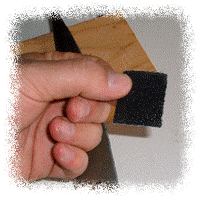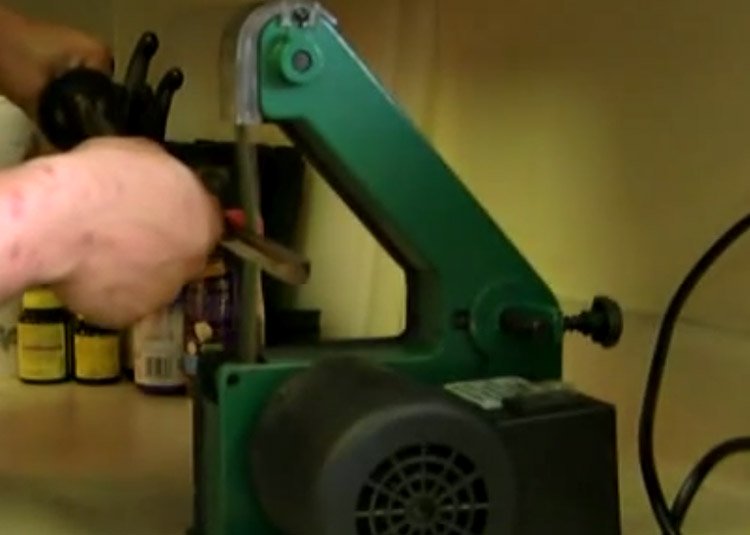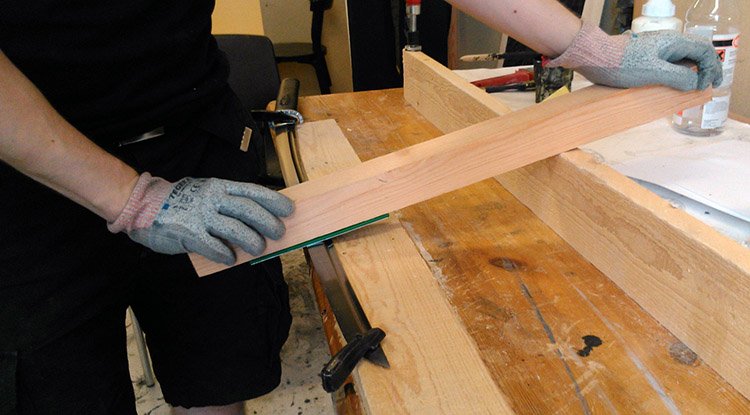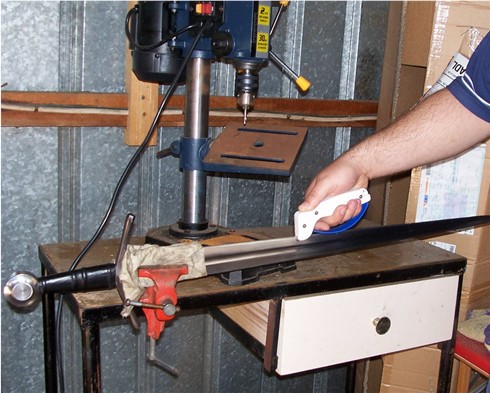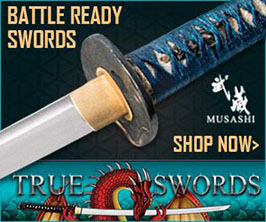- Home
- Sharpening Guide
How to Sharpen a Sword
I often get asked how to sharpen a sword.
Whether it is because the sword is unsharpened or simply not as sharp as you would personally want it to be or has become dull with use, knowing how to sharpen a sword is a skill that EVERY serious sword collector should have.
In this section of the site we will be looking at a variety of sharpening methods, including:
- The Old Fashioned way - sharpening by hand
- The modern way - sharpening with sanding belts
- The consistent and easy way - DIY Sharpening rack &
- The quick & lazy way a tool known as the 'accusharp'
However, one important caveat - BEFORE you decide to sharpen your sword, there is one very important thing you need to consider..
Does this sword really NEED sharpening?
Why Not Razor Sharp?
There are several reasons why a new sword will not come razor sharp out of the box - one is simply cost. It takes a lot of time to polish a blade until it is razor sharp - and the more time spent on a sword, the higher the price. As such, many companies concentrate on just making a good sword with decent polish and if you want to take it to crazy razor sharp, well - that's up to YOU and how much time you want to spend 'perfecting it'.
The other reason is safety. Razor sharp swords are dangerous to handle and ship, and could result in all kinds of legal issues. So most manufacturers only sharpen their swords to the degree necessary to cut standard targets and no more.
The third reason is durability.
For these reasons, most new swords are only moderately sharp - leaving it up to the new owner to decide for themselves how sharp they want to make it.
There are several reasons why you might not actually want to sharpen your sword at all.
The first is, if the sword is going to be used for training purposes it is MUCH better off if it is not sharpened.. The reasons for this should be quite obvious, if the sword is unsharpened the chances of an accidental life threatening injury are GREATLY reduced..
But the second reason comes into play when you receive a cutting sword that does not feel sharp to casual observation or not as sharp as you were expecting.
This is much more common on Japanese Katana than any other style of blade. For one reason or another, many people think that a Japanese sword should be RAZOR sharp. But a sword can be too sharp - and you might be surprised to learn that a sword that feels razor sharp, if used in a battle would chip on the opponents bone. While one that feels unsharp and that you can even run your fingers along, would take their arm off at the shoulder..
This is due to the fact that the best made Japanese swords have what is called 'Niku' - which is basically the Japanese word for 'meat'.
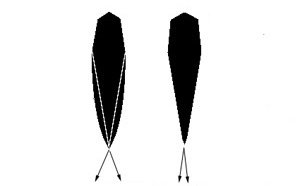 Sword with niku (left) and without
Sword with niku (left) and withoutA quick look at the diagram demonstrates the difference between a Katana with niku and one without.
In cases where the sword does not FEEL sharp, but has Niku, the best way to know if it is sharp enough is by actually cutting with it (using correct technique, not just hacking but SLICING - Japanese sword techniques are described in detail here).
For more information on how to sharpen a Katana - from the traditional method that takes days to modern shortcuts you can achieve a mirror polish in a few hours, click here
Taking a Katana with Niku and applying the wrong sharpening technique is not a very good idea. However, if you do wish to just touch up the edge a little you can do so with a small square of fine steel grade abrasive paper, a little water and CAREFULLY run it at a 30 degree angle slowly along the blade's length one way and then again on the other side to clean up any microscopic burrs.
But I am getting ahead of myself here - this is actually step 3 of the most basic 3 step sharpening process, so let's take a look at how to sharpen a sword using this basic, tried and true method.
Basic Sharpening Principles
Before we get to the various ways on how to sharpen a sword, there is a 20 minute video that explains the core concepts of sharpening with a ton of useful tips that while are focused on tools apply perfectly to swords and any other blade. The video is basically a free sharpening masterclass in 20 mins and well worth your time to watch it.
How to Sharpen a Sword - Method 1
File, Whetstone & Sandpaper
One of the most basic ways to sharpen a sword is what I call the 'file and whetstone' method. While it can be time consuming, it is also of the safest methods that can produce an extremely good result.
Naturally enough, as it is entirely done by hand, you need to spend some time practicing before you get it down pat. Sharpening sword is as much an art as it is a science, so we do recommend that you practice first on a cheap machete, knife or (heavens forbid) a stainless steel el-cheapo wallhanger.
To learn the 'file and whetstone' technique:
How to Sharpen a Sword - Method 2
Tom Kinders Methods - Universal Sharpening by Hand or Sanding Belt
Method two is actually several methods to sharpen a sword - from Katana to medieval - by hand with sandpaper, files or whetstones and also using a sanding belt.
Now generally, it is not recommended to use power tools in a casual manner as the friction will heat up the blade, ruining the temper. However, there are some tools and techniques you can use to minimize the chance of any tempering interference as explained here.
The end result is always a scary razor sharp blade - so if you want to take it to the extreme, use Toms methods.
To learn how to sharpen a sword until it is SCARY sharp:
How to Sharpen a Sword - Method 3
'Poor Man's sharpening rack'
Using nothing more than a sharpening stone, some blocks of wood and a few clamps it is possible to make a sword sharpening kit at home for pennies on the dollar that gets a consistent edge with minimal effort and in a short amount of time. A very clever and effective method indeed.
To learn this this quick and easy method:
How to Sharpen a Sword - Method 4
How to Sharpen a Sword the Lazy Way..
The fourth technique is considered by many to be 'cheating' because it is simple, fast and creates a secondary bevel from a cheap hand held tool called the "accusharp".
Now normally a secondary bevel is considered an inferior cutting angle for a sword. However, if the steel is good quality and you are looking for 'shortcut' - this method is the easiest of them all.
To learn how the lazy way to sharpen a sword:
Bonus Method to Sharpen & Polish Katana
Developed over 50 years of experienced with blades and edges weapons, this tutorial is an easy and modern way to polish and sharpen a Japanese sword to razor sharp. mirror finish perfection - without needing to spend weeks doing it like a Togishi..
To learn this method of sharpening & polishing a Katana:
Related Article - How to Bring Out a Hamon
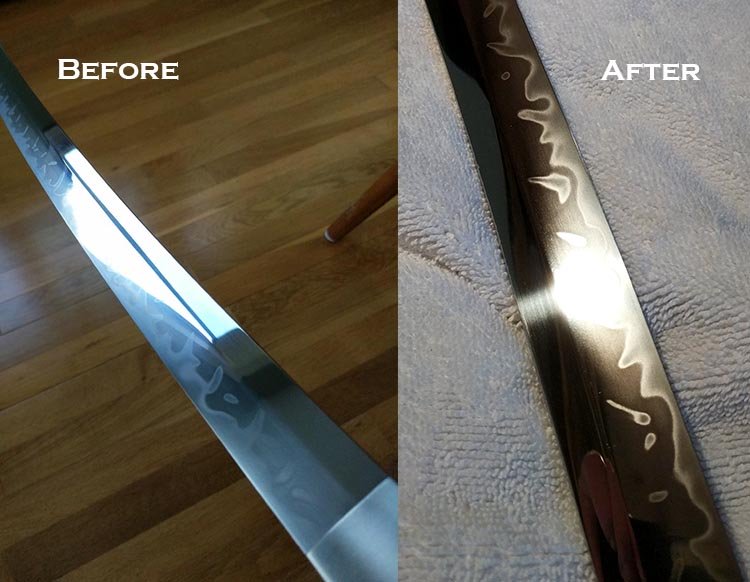
If your sword has a genuine hamon temper line, the polishing technique above will get it all nice and shiny and razor sharp, but the hamon will be lost and obscured by the polish as part of the process. Here are 4 of the easiest methods to bring it back, and some additional information on modern and traditional polishing techniques, including polishing with Japanese water stones, hybrid polishing and easy acid etching with lemon or vinegar that you can do at home (plus some other even easier and more radical solutions!). CLICK HERE to find out how.
Of course, there are many, many other techniques you can use to sharpen a sword, and of course a given technique that may work well on one type of sword may not work as well on another, just as one technique may also work well for a given individual person and not another.
Each person finds their own method in time. The key to becoming a successful and consistent sword sharpener can be summed up in one word..
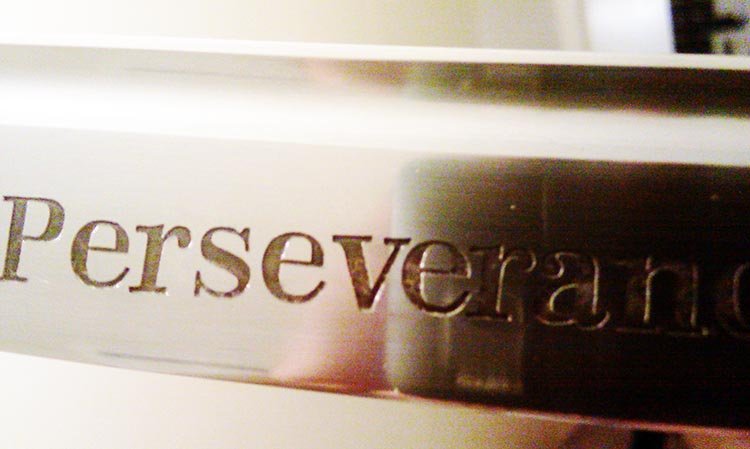 Perseverance: the key to becoming a skilled sword sharpener
Perseverance: the key to becoming a skilled sword sharpenerTo read more methods of sword sharpening or share your own techniques or tools that work for you have a look below.
What's YOUR sword care tip?
Do you have some tips on sharpening a sword that isn't covered here? Share it!
Visitor Submitted Sword Care Tips
Click below to see contributions from other visitors to this page...
Razor Edge Systems
I have request sharpening of a cold steel light cavalry saber by this professional, but he declined on the grounds of it being too dangerous. https://www.razoredgesystem …
Learning from the Ladies - Part 2
In my last post (“Learning from the ladies” under the sword sharpening guide section of this site) I wrote of my experiments in blade sharpening using …
Sharpening stone/wetstone
Simply use the course side of the stone to create the edge of your liking then finish with the fine side until you achieve the edge you choose. Of course …
Learning from the ladies
I recently purchased a Chinese made wakisashi with a folded steel blade and more or less common fittings. This was my first foray into Chinese Japanese …
SAND PAPER LEAVESS OF DIFFERENT SIZES...
Nothing special really...
About how to prevent too much rust on your blades...
Using before some grinding and sharpening stones of different sizes, …
Window Sharp?
Before I explain I have never actually used this technique beacause my preffered method is a whetstone and oil but have friends that swear by it in a pinch. …
Take your time!!!
I have an Accusharp Knife Sharpener (as listed on your website). Without a doubt this thing works INCREDIBLY WELL!!! Its pretty cheap and it doesnt take …
tried attempt with power tool that worked
well, first of all, don't worry, I didn't use any big grinder of any sort. I tried a flap wheel (like this one).
Mounted on a press drill (so …
a whetstone substitute
I rubbed my machete on a brick, like a whetstone, and it gave my machete a crude, yet razor edge. If you cannot afford a whetstone, I recommend using a …
The best way to sharpen
The best way to get a edge on any sort of blade is to use a wet stone, the only trick is getting the angle right. Insted of using watter use oil, simply …
"stay sharp sword sheath"
Well this is an idea i have had for a while now and is intended for custom or home made swords but the whole concept is a sheath that whenever you draw …
I hate to say it....
I really hate to say it, but I've tried to find different ways to sharpen my swords and knives, and BELIEVE IT, or most likely not, The Samurai Shark, …
My way of sharpening katana (as seen on SFI)
I'd just like to highlight a post on SFI (which can be difficult to search), describing the method I use to sharpen my katana-blades:
http://forums.swordforum.com/sho …
Avoiding Cuts
When polishing a sword, knife or any sharp implement, there is always a high risk of cutting fingers of limbs. To avoid this, here are a few tips:
- …
I hope our guides on how to sharpen a sword have been helpful. To return to the Sword Buyers Guide homepage from How to Sharpen a Sword, click here


